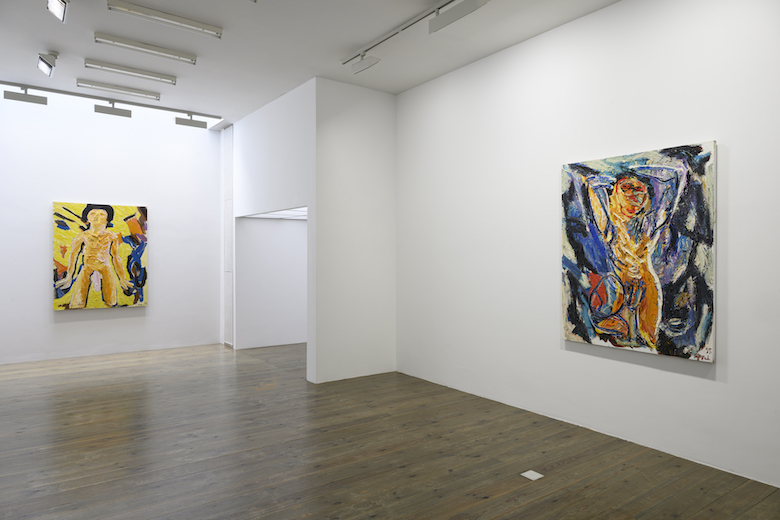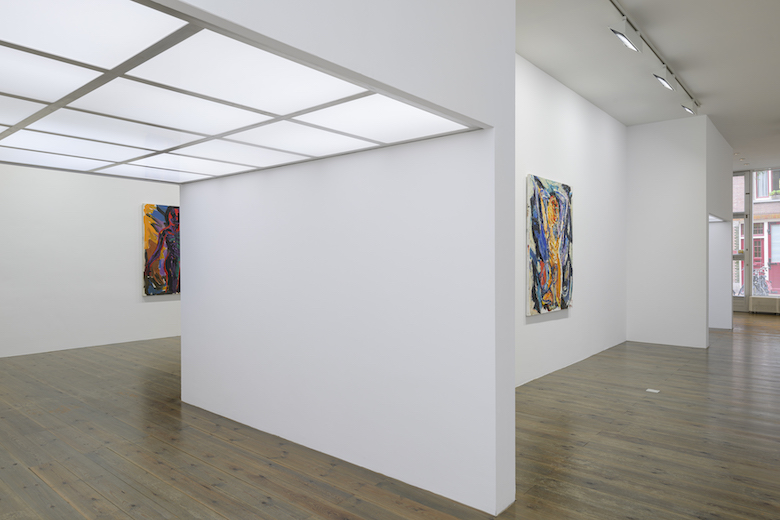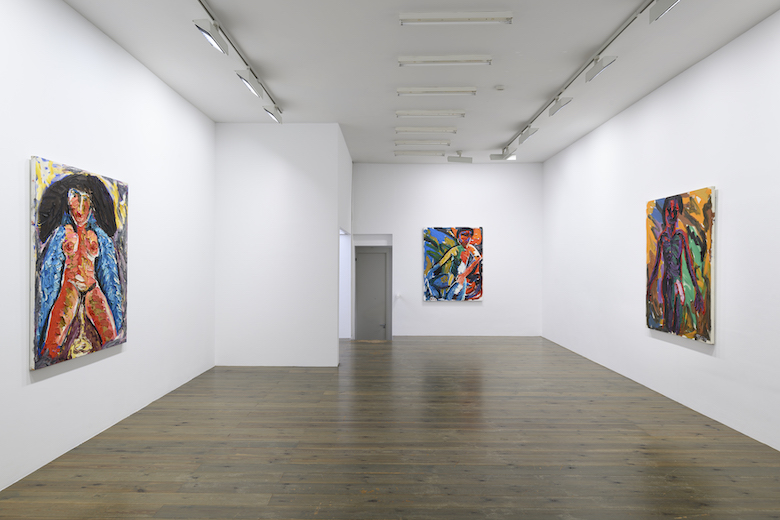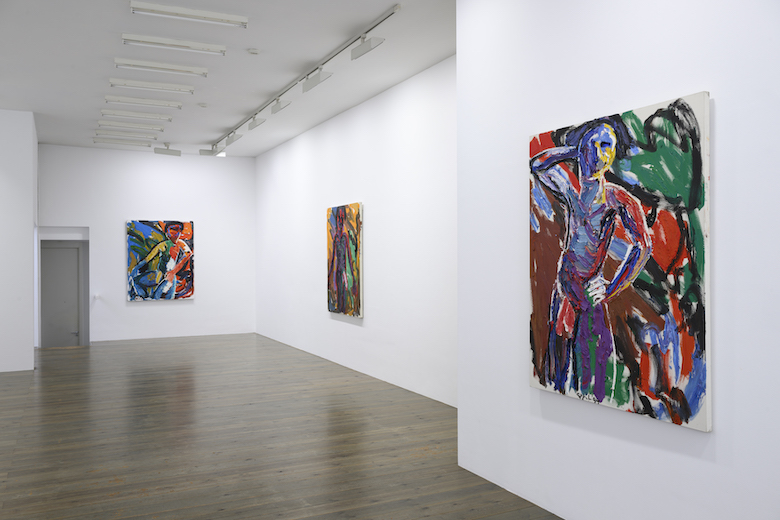









Slewe Gallery is pleased to announce the opening of the exhibition (Fe)Male by Karel Appel (1921-2006), one of the most important Dutch artists of the second half of the twentieth century. The exhibition features eight of Appel’s Nude paintings from the years 1994 and 1995. It opens on October 12 and will be on view until November 16. With this exhibition, Slewe Gallery celebrates its 30th anniversary.
The female and male figures featured in these paintings by Karel Appel emerge from a background of rough, loose streaks of oil paint. They have been painted masterfully in a wet-on-wet technique and are given as an expression bold confidence. The colorful brush strokes with which the figures have been constructed extend into the surrounding background. Head, torso, arms and thighs fill the tight space. Legs and feet are cut off at the picture’s edge. These nudes come at the viewer frontally and unabashedly.
As a classical painter, Karel Appel kept on returning to timeless motifs such as figure and landscape. The nudes shown here were made in New York during the years 1994 and 1995. During that same period Appel also painted landscapes in Tuscany, which have been on view previously at Slewe. These were monumental, horizontally oriented paintings of views from his house in Tuscany. These 'reclining' Italian landscapes are a pendant to the upright figures of New York. The lyrical and cosmic quality of nature as opposed to bold, raw urban life.
In recent years, Appel's late works have received increasing international attention with major exhibitions in internationally renowned galleries such as Max Hetzler in Berlin and London, Jahn und Jahn in Munich, Galerie Ulysses in Vienna, BLUM (former Blum and Poe) in Los Angeles and New York, and Almine Rech in Paris. Slewe Gallery has previously shown Appel’s late work in the 2011 exhibition Couplet 7, curated by Rudi Fuchs, a group of abstract paintings from 1978-1980 in Reset in 2016 and, in 2021, paintings and works on paper from the series Horizon of Tuscany from 1995. This exhibition is again organized in close collaboration with the Karel Appel Foundation. A catalog will be published.
Slewe Gallery is pleased to announce the opening of the group exhibition Brainwave, including a selection of works by Alan Charlton, Callum Innes, Dan Walsh, Domencio Bianchi, Jan van Munster, Jerry Zeniuk, Joris Geurts, Karel Appel, Krijn de Koning, Michael Jacklin, Steven Aalders.
The exhibition will be on view from September 4 to October 9. The gallery is open from Wednesday to Saturday from 1 to 6 pm and by appointment.
The exhibition with new work by Domenico Bianchi and Nunzio, previously scheduled for September, has been postponed to spring 2022.
This year it is 100 years since the birth of the most famous post-war Dutch artist, Karel Appel (1921–2006). To mark this occasion, Slewe Gallery is pleased to host Horizon of Tuscany, an exhibition of work by Appel. This will open during the weekend of his birthday, April 25, and the works will remain on view until June 27, 2021. The exhibition has been arranged by Rudi Fuchs, the former director of the Stedelijk Museum and a close friend of Karel Appel, and organised in collaboration with the Karel Appel Foundation. It will be accompanied by a catalogue, designed by Rutger Fuchs. Also, you can listen to a conversation between Harriet Appel-de Visser, Appel's widow, and Robert van Altena on this exhibition here.
The exhibition will show a selection of five paintings from Appel’s Horizon of Tuscany series from 1995, when the artist was 74 years old. The works all have an elongated format, measuring 115 x 300 cm, and are in the artist’s late style. In the nineties, Appel, known for his baroque expressionist painted figures and nudes, concentrated on the landscape as a subject. This was a motif he had not previously explored in such depth. Living in Tuscany at the time, he started to paint a number of landscapes ‘after nature’, featuring the hills and cypresses around the house. The motifs of trees and hills are absorbed into an all-over pattern of rhythmically applied brushstrokes. A waving, pulsating surface arises, like a colourful tapestry. In addition to these paintings, some works on paper based on the same theme and from the same period will be on display.
Appel’s late-style works have been receiving increasing international interest, with exhibitions at Blum and Poe in Los Angeles, Max Hetzler in Berlin, Jahn und Jahn in Munich and Almine Rech in Paris. Slewe Gallery has previously shown Appel’s work in 2011, in the exhibition Couplet 7, curated by Rudi Fuchs, and in 2016, with a group of abstract paintings from 1978–1980, entitled Reset. The forthcoming exhibition, Horizon of Tuscany, at Slewe Gallery is part of a series of activities to mark the 100th anniversary of Appel’s birth. The celebrations started at Galerie Max Hetzler in Berlin with an exhibition of his sculptures; this summer Jahn und Jahn will publish a catalogue, entitled Karel Appel, Collages from 1957–1968; and in September EenWerk in Amsterdam will show two of his object paintings from the eighties.
When you think of the artist Karel Appel (1921-2006) you see wild colourful, expressionistic brush strokes, accompanied by Jazz Music of Dizzy Gillespie, or primitive drawings by children and strong coloured baroque images. The most well known Dutch painter after World War II painted ‘from the expression’. However his painterly career has shown another side as well. Around 1975, after an impasse, he renewed his oeuvre by going back to the basics of painting it self. His way of working became more meditative and abstract. This period is not well known and not valued well by most people in the art world. A selection of eight paintings from this period 1978-1980 will now be on view at Slewe Gallery from January 16 through March 5.
The paintings, originated in the South of France, feature a new palette of broken tones. Whereas in the early years Appel mixed his colours directly with a palette knife on the canvas, now they are mixed beforehand and applied with broad brushes. Motifs as trees and field are absorbed in an all over pattern of ritmic applied straight brushstrokes. A waving pulsating surface arises as a colourful tapestry or an open field in nature.
Appel himself said about this period, he had enough of his baroque painting and was looking for a new starting point in order to come to a new imagery. These painting show the path to this new style. Using a flat brush, he starts working in a rather atypical, disciplined style of more controlled, short brushstrokes, which are rhythmically patterned across the canvas. In those years Appel saw a new catalogue on the work of Vincent Van Gogh, which turned out to be an important source of inspiration.
The exhibition is part of a new interest in the work of Karel Appel. At the same time an overview of his work will open at the Gemeentemuseum The Hague, which runs form January 16 to May 16. At the Staatliche Graphische Sammlung München of the Pinakotek der Moderne an overview of his drawings will open February 4, which had been earlier on view at the Centre Pompidou. Summer 2016 an exhibition with his works will be opened at the Philips Collection in Washington and in 2107 there will be a large overview at the Musée d’Art Moderne de la Ville in Paris. The exhibition has been organized in collaboration with the karel Appel Foundation. For more information please contact the gallery.
Couplet 7: Karel Appel, Domenico Bianchi, Georg Herold (Curator: Rudi Fuchs)
Slewe Gallery is pleased to announce the opening of a special exhibition curated by former Stedelijk Museum director Rudi Fuchs, entitled Couplet 7. Participating artists are Karel Appel (1921-2006, NL), Domenico Bianchi (*1955, IT) and Georg Herold (*1947, DE). The exhibition will open Saturday November 19 and will last until December 17, 2011.
The title of the exhibition refers to the famous series of Couplet exhibitions Rudi Fuchs curated at the Stedelijk Museum Amsterdam in the nineties of the last century. In these highly esthetic exhibitions he pointed out his unconvential vision, in which juxtaposted art works showed surprising dialogues, visually as well as in content. With a selection of recent never shown works by Appel, Bianchi and Herold Couplet 7 is a follow up of these series in a condensed form.
Of Karel Appel, the great Dutch expressionist painter who died in 2006, two of his last and never exhibited paintings from 2004 will be shown. They are monumental works depicting a standing figure in a landscape.
The Italian artist Bianchi will show two newly made works. He has developed his own technique of mixing wax and oil paint, sometimes combined with Palladium leaf. His images with a perpetuum mobile motive derive from computer programs.
Herold, known for his sculptures and assembled paintings with unconventional materials, such as bricks, caviar, vodka-bottles and mattresses, will show a new sculpture of a 3 meters high standing figure. His work has a relation to arte povera, but also bears political connotations as a result of his East German background.
Rudi Fuchs has written a special statement for this exhibition. Especially designed by Irma Boom it will be part of the show.